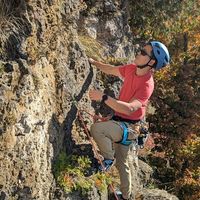Back from a trip to the Lake District.
-
Back from a trip to the Lake District. On the negative side, I didn't get three days climbing... On the super-positive side, I did get two days of Mountain Training Development Coach training with the ever-excellent John Kettle PLUS a day of climbing at Trowbarrow Quarry. As a bonus, also a nice stay at Lyndhurst Guest House in Kendal and a play at KendalWall on their long autobelays.
#MountainTraining #Climbing #TradClimbing #Coaching #ClimbingIsMyPassion #Kendal #LakeDistrict #LimestoneClimbing



-
Back from a trip to the Lake District. On the negative side, I didn't get three days climbing... On the super-positive side, I did get two days of Mountain Training Development Coach training with the ever-excellent John Kettle PLUS a day of climbing at Trowbarrow Quarry. As a bonus, also a nice stay at Lyndhurst Guest House in Kendal and a play at KendalWall on their long autobelays.
#MountainTraining #Climbing #TradClimbing #Coaching #ClimbingIsMyPassion #Kendal #LakeDistrict #LimestoneClimbing



Ooh, Trowbarrow - haven't been there in decades. What did you do?
-
Ooh, Trowbarrow - haven't been there in decades. What did you do?
Apart from JJ, by the looks of it!
-
Ooh, Trowbarrow - haven't been there in decades. What did you do?
@Badgardener Warmed up on Barrier Reef (fun), then did Harijan (definitely harder) after Jean Jeanie (both fab routes). Also seconded seconded Coral Sea, Hollow Earth and Assagai - all fun and wouldn't mind trying a lead on a less slippery day.
-
@Badgardener Warmed up on Barrier Reef (fun), then did Harijan (definitely harder) after Jean Jeanie (both fab routes). Also seconded seconded Coral Sea, Hollow Earth and Assagai - all fun and wouldn't mind trying a lead on a less slippery day.
I think it's exactly 25 years since I was last there - and it was polished to Sod then. Good effort on a November day!
-
I think it's exactly 25 years since I was last there - and it was polished to Sod then. Good effort on a November day!
@Badgardener
 Clearly you've never been to Wyndcliffe Quarry in the Wye, The Cuttings on Portland, or (especially) New Wall in Avon Gorge if you think that's polished! Still, it *was* a little slick in places... but as much down to being mildly damp air as the polish. The worst bit was the sheltered bit under the roof on Harijan and Hollow Earth that was all kinda damp-dusty.
Clearly you've never been to Wyndcliffe Quarry in the Wye, The Cuttings on Portland, or (especially) New Wall in Avon Gorge if you think that's polished! Still, it *was* a little slick in places... but as much down to being mildly damp air as the polish. The worst bit was the sheltered bit under the roof on Harijan and Hollow Earth that was all kinda damp-dusty. -
 D devnull moved this topic from Uncategorized on
D devnull moved this topic from Uncategorized on
-
@Badgardener
 Clearly you've never been to Wyndcliffe Quarry in the Wye, The Cuttings on Portland, or (especially) New Wall in Avon Gorge if you think that's polished! Still, it *was* a little slick in places... but as much down to being mildly damp air as the polish. The worst bit was the sheltered bit under the roof on Harijan and Hollow Earth that was all kinda damp-dusty.
Clearly you've never been to Wyndcliffe Quarry in the Wye, The Cuttings on Portland, or (especially) New Wall in Avon Gorge if you think that's polished! Still, it *was* a little slick in places... but as much down to being mildly damp air as the polish. The worst bit was the sheltered bit under the roof on Harijan and Hollow Earth that was all kinda damp-dusty.Been to the cuttings, when it was the awful combo of horribly polished and sparsely bolted on some of the easier routes!
The Avon Gorge is like Dignitas for climbers - you only go there when you're tired of life.
-
Apart from JJ, by the looks of it!
@Badgardener Well spotted on the route btw...

-
@Badgardener Well spotted on the route btw...

It's a National Bloody Treasure, to be fair, and pretty much synonymous with Trowbarrow...
-
It's a National Bloody Treasure, to be fair, and pretty much synonymous with Trowbarrow...
@Badgardener It *is* a pretty epic line at the grade to be sure